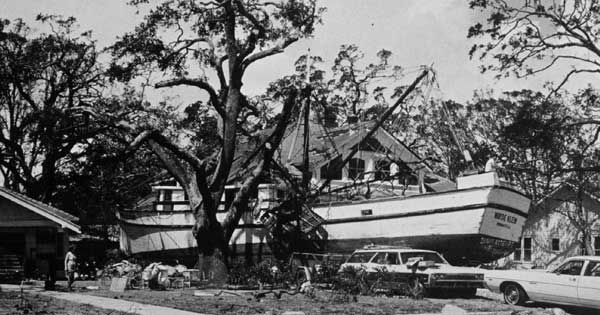
Camille, 1969: Histories of a Hurricane, by Mark M. Smith, The University of Georgia Press, 71 pp., $24.95
On August 17, 1969, a Category 5 hurricane ripped through southern Mississippi, generating sustained winds of 190 miles per hour, powerful enough to skin a human body. More than just a storm, Hurricane Camille was a catastrophe that left survivors and their landscape scarred beyond recognition. By the time it died three days later, Camille had killed 143 people and injured 9,000 others.
Hurricane Katrina, which also reached Category 5 status, landed in southeast Louisiana in August 2005, and the atrocities Katrina wrought are well documented. University of South Carolina history professor Mark Smith focuses here on Camille, a wild and boundless disaster he manages to contain in his book’s neat architecture: a trio of fine and slender essays that detail the damage Camille did to the economic, social, and political landscape of desegregation-era Mississippi.
Camille, 1969, adapted from a series of lectures delivered at Mercer University in Macon, Georgia, grew out of Smith’s involvement in a National Science Foundation project designed to examine recovery trajectories from natural disasters. Smith is uneasy with the word recovery, however, and prefers the term recovering, which, he believes, more accurately defines the endless process of personal and public healing necessary to recuperate from disasters like Camille.
Smith is a prominent historian of the antebellum South, and, for the last 10 years, he has put his unique signature on the field of sensory history. As he explains early in the book, “Sensory history tends to consider not only the history of a given sense but also its social and cultural construction.” Smith’s descriptions border on the poetic: “Thirst, the absence of liquid on tongues accustomed to easy quenching, was a feeling horrible in its novelty.” Smells of rotten food and sewage permeated the air. The sounds of chain saws and howling winds haunted victims of Camille for years afterward. Wind and rain treated skin with “contempt.” Clean, dry clothing was hard to come by, and victims had to contend with constant “bone-grinding damp.”
Smith’s writing lends elegance to the devastation, which drove southern Mississippi back to pre-modern times. Ordinary conveniences like plumbing and refrigeration were ruined, and victims had to rely on natural light in order to contend with a world that no longer made sense. Smith includes photographs of the wreckage, but they appear flat and plain when juxtaposed with the portraits he paints in words.
Camille turned traditional racial hierarchies on their heads. Conventional prohibitions against interracial touching were suspended, and black and white survivors embraced with impunity. But this interracial communion was only temporary, and the calamity quickly fell into lockstep with the historical mess of southern race relations. Smith portrays Camille as a natural disaster that “barreled into, and cobbled onto, a manmade one” that was “equally replete with dead bodies, withered edifices, flattened horizons, and disturbing sights.” Evacuation buses were segregated, and black people were not welcome at the central evacuee center. Most significantly, Camille became intimately identified with the battle over school desegregation. Guy H. Clark, chief of field operations for the U.S. Office of Education, took advantage of the political vulnerability created by the storm to force Mississippi schools to comply with Title VI of the Civil Rights Act of 1964. Schools that failed to comply would not receive federal assistance. A passionate battle over funding ensued, involving the U.S. Department of Health, Education, and Welfare (HEW), the Nixon administration, and the state of Mississippi. Camille had become a civil-rights issue and a portal onto a centuries-old history of racial injustice in Mississippi. When the battle ended, the Nixon administration forced Leon Panetta, the defense secretary designate who was then director of the Office for Civil Rights, to resign. But Smith doesn’t view this as a failure. Instead, he sees imagination in the ambitions of Panetta and HEW, which demonstrated, he argues, an understanding of how intimately related natural disasters are to their social contexts.
In his final essay, Smith turns to the economic devastation the storm created. Insurance proved unreliable, so people turned to the Red Cross, which favored white middle-class homeowners: one middle-class family received a full bedroom set while a poor family with the same level of need received only a mattress. Race and class played central roles in decisions about how to allocate resources, on both a local and federal level. Victims of Camille appealed to the U.S. Department of Housing and Urban Development (HUD) for trailers, but the process was biased against poor people, who could not afford to clear debris from their lots, a condition of HUD assistance. Those people who did receive HUD trailers could apply to the U.S. Small Business Administration (SBA) for funds to rebuild their homes. But like the HUD applications, the lengthy and complicated SBA application process was too difficult to manage for people of limited education.
“For those without resources,” writes Smith, “the hurricane and the relief policies underwriting recovery arguably helped create a new class of poor in southern Mississippi.” But for the business and tourist communities, the devastation of Camille quickly gave way to opportunity. “Banks. New hotels. Convention centers. Yacht clubs. Pleasure-craft harbors. Golf courses. Was this sort of growth necessary for sustained and equitable recovery?” Smith asks. His book does not offer pat solutions to the crises generated by natural disasters. The strengths of Camille, 1969 lie in Smith’s provocative questions; in his seamless fluency in the languages of politics, economics, and history; and in his poetic gift of storytelling. His book is not simply a historical account of a single hurricane, but a story about the ethics of recovery. Without an honest reckoning of the storm’s moral implications, Smith concludes, “we seem doomed to perpetuate the recovery divide the next time a powerful Atlantic storm decides to cut its teeth on southern soil.”

